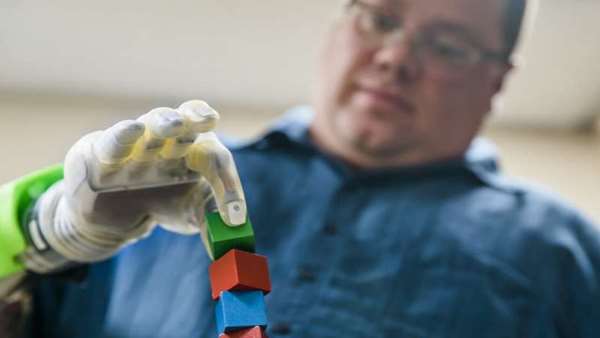'It's like you have a hand again': An ultra-precise mind-controlled prosthetic
In a major advance in mind-controlled prosthetics for amputees, University of Michigan researchers have tapped faint, latent signals from arm nerves and amplified them to enable real-time, intuitive, finger-level control of a robotic hand.
In a major advance in mind-controlled prosthetics for amputees, University of Michigan researchers have tapped faint, latent signals from arm nerves and amplified them to enable real-time, intuitive, finger-level control of a robotic hand.
To achieve this, the researchers developed a way to tame temperamental nerve endings, separate thick nerve bundles into smaller fibers that enable more precise control, and amplify the signals coming through those nerves. The approach involves tiny muscle grafts and machine learning algorithms borrowed from the brain-machine interface field.
"This is the biggest advance in motor control for people with amputations in many years," said Paul Cederna, who is the Robert Oneal Collegiate Professor of Plastic Surgery at the U-M Medical School, as well as a professor of biomedical engineering.
"We have developed a technique to provide individual finger control of prosthetic devices using the nerves in a patient's residual limb. With it, we have been able to provide some of the most advanced prosthetic control that the world has seen."
Cederna co-leads the research with Cindy Chestek, associate professor of biomedical engineering at the U-M College of Engineering. In a paper published March 4 in Science Translational Medicine, they describe results with four study participants using the Mobius Bionics LUKE arm
"You can make a prosthetic hand do a lot of things, but that doesn't mean that the person is intuitively controlling it. The difference is when it works on the first try just by thinking about it, and that's what our approach offers," Chestek said. "This worked the very first time we tried it. There's no learning for the participants. All of the learning happens in our algorithms. That's different from other approaches."
While study participants aren't yet allowed to take the arm home, in the lab, they were able to pick up blocks with a pincer grasp; move their thumb in a continuous motion, rather than have to choose from two positions; lift spherically shaped objects; and even play in a version of Rock, Paper, Scissors called Rock, Paper, Pliers.
"It's like you have a hand again," said study participant Joe Hamilton, who lost his arm in a fireworks accident in 2013. "You can pretty much do anything you can do with a real hand with that hand. It brings you back to a sense of normalcy."
Turning a tiny muscle graft into a nerve signal amplifier
One of the biggest hurdles in mind-controlled prosthetics is tapping into a strong and stable nerve signal to feed the bionic limb. Some research groups—those working in the brain-machine interface field—go all the way to the primary source, the brain. This is necessary when working with people who are paralyzed. But it's invasive and high-risk.
For people with amputations, peripheral nerves—the network that fans out from the brain and spinal cord—have been interesting, but they hadn't yet led to a long-term solution for a couple of reasons: The nerve signals they carry are small. And other approaches to picking up those signals involved probes that eavesdropped by force. These "nails in nerves," as researchers sometimes refer to them, lead to scar tissue, which muddles that already faint signal over time.
The U-M team came up with a better way. They wrapped tiny muscle grafts around the nerve endings in the participants' arms. These "regenerative peripheral nerve interfaces," or RPNIs, offer severed nerves new tissue to latch on to. This prevents the growth of nerve masses called neuromas that lead to phantom limb pain. And it gives the nerves a megaphone. The muscle grafts amplify the nerve signals. Two patients had electrodes implanted in their muscle grafts, and the electrodes were able to record these nerve signals and pass them on to a prosthetic hand in real time.
Reference: https://medicalxpress.com/news/2020-03-ultra-precise-mind-controlled-prosthetic.html




ارسال به دوستان